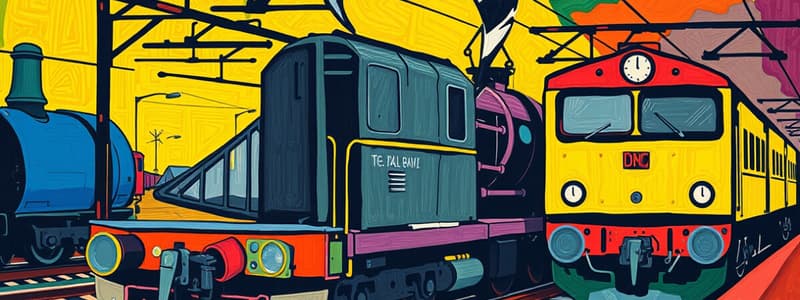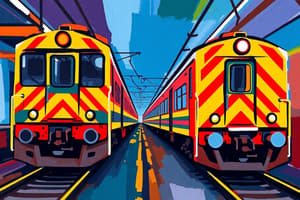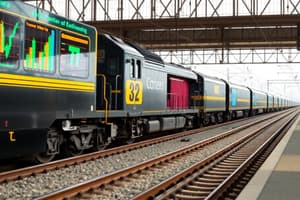Podcast
Questions and Answers
What is a passenger train primarily intended for?
What is a passenger train primarily intended for?
- Carrying freight
- Transporting goods
- Service maintenance
- Carrying passengers (correct)
Point and trap indicators are considered signals.
Point and trap indicators are considered signals.
False (B)
What does the term 'running line' refer to?
What does the term 'running line' refer to?
The line governed by one or more signals and includes connections used by a train when entering, leaving, or passing through a station.
A train which has started under an authority to proceed is referred to as a __________.
A train which has started under an authority to proceed is referred to as a __________.
Match the following terms with their definitions:
Match the following terms with their definitions:
What are special instructions?
What are special instructions?
Station limits refer to the area under the control of a Station Master.
Station limits refer to the area under the control of a Station Master.
What is a subsidiary rule?
What is a subsidiary rule?
A __________ is an electrical circuit used to detect vehicles on the track.
A __________ is an electrical circuit used to detect vehicles on the track.
What is the main purpose of Railway Signalling Systems?
What is the main purpose of Railway Signalling Systems?
Fixed signals can include only visual signals.
Fixed signals can include only visual signals.
Define a 'Fixed Signal' in the context of railway operations.
Define a 'Fixed Signal' in the context of railway operations.
Semaphore signals are typically in the form of a rectangular or ______ arm fixed to a vertical post.
Semaphore signals are typically in the form of a rectangular or ______ arm fixed to a vertical post.
Match the methods of semaphore arm positions with their descriptions:
Match the methods of semaphore arm positions with their descriptions:
Which of the following signals were eliminated due to misleading information?
Which of the following signals were eliminated due to misleading information?
The Left hand rule is followed in Indian Railways.
The Left hand rule is followed in Indian Railways.
What happens when the semaphore arm is made to disappear in a slot?
What happens when the semaphore arm is made to disappear in a slot?
What is one major problem of railway locomotion compared to other forms of transport?
What is one major problem of railway locomotion compared to other forms of transport?
Fixed Signals can operate on any one of the four quadrants of a ______.
Fixed Signals can operate on any one of the four quadrants of a ______.
Which signals are explicitly mentioned as part of railway signalling systems?
Which signals are explicitly mentioned as part of railway signalling systems?
Steel wheels on steel rails have the highest friction among transportation methods.
Steel wheels on steel rails have the highest friction among transportation methods.
What is required to prevent trains coming from opposite directions from colliding on a single track?
What is required to prevent trains coming from opposite directions from colliding on a single track?
The rolling of a steel wheel on steel rail is one of the most efficient means of __________.
The rolling of a steel wheel on steel rail is one of the most efficient means of __________.
Match the following types of train control with their descriptions:
Match the following types of train control with their descriptions:
What should be done when encountering a red (R) home signal?
What should be done when encountering a red (R) home signal?
Which method is specifically mentioned for spacing trains running in the same direction?
Which method is specifically mentioned for spacing trains running in the same direction?
A yellow (Y) signal indicates the train should stop at the next signal.
A yellow (Y) signal indicates the train should stop at the next signal.
Two separate tracks are always necessary for trains running in opposite directions.
Two separate tracks are always necessary for trains running in opposite directions.
What does a green (G) signal indicate for a train approaching the station?
What does a green (G) signal indicate for a train approaching the station?
What is crucial for train drivers when a preceding train stops?
What is crucial for train drivers when a preceding train stops?
If an advanced starter signal shows a yellow (Y), the train should __________ up to the advanced starter.
If an advanced starter signal shows a yellow (Y), the train should __________ up to the advanced starter.
With low speeds and weights, it is easier for a following train to __________ short of the train ahead.
With low speeds and weights, it is easier for a following train to __________ short of the train ahead.
Match the following signal aspects with their corresponding indications:
Match the following signal aspects with their corresponding indications:
Match the following rail safety concepts:
Match the following rail safety concepts:
When both distant signals show yellow (YY), what indication does the home signal provide?
When both distant signals show yellow (YY), what indication does the home signal provide?
What is the purpose of a 'WARNER' signal in 2-Aspect signalling?
What is the purpose of a 'WARNER' signal in 2-Aspect signalling?
The 'HOME' signal permits the train to leave the station.
The 'HOME' signal permits the train to leave the station.
What are the names of the two stop signals provided when trains approach a station?
What are the names of the two stop signals provided when trains approach a station?
The signal placed below the first stop signal is called a _____ signal.
The signal placed below the first stop signal is called a _____ signal.
Match the following signals with their descriptions:
Match the following signals with their descriptions:
What is an advanced starter signal designed to protect?
What is an advanced starter signal designed to protect?
At the departure end of the station, a single stop signal is sufficient for train movement.
At the departure end of the station, a single stop signal is sufficient for train movement.
How many DISTANT signals are provided if the sectional speed is 120 KMPH or above?
How many DISTANT signals are provided if the sectional speed is 120 KMPH or above?
A stop signal between the Home signal and the Reception lines is called a _____ HOME signal.
A stop signal between the Home signal and the Reception lines is called a _____ HOME signal.
What is the minimum number of permissive and stop signals required for trains approaching a station?
What is the minimum number of permissive and stop signals required for trains approaching a station?
Flashcards are hidden until you start studying
Study Notes
Train Definitions and Operations
- Passenger Train: Designed mainly for passengers and coaching traffic, including troop trains.
- Point and Trap Indicators: Devices indicating the position of track switches, functioning both day and night but not considered signals.
- Running Line: The track governed by one or more signals, including connections for train entering, leaving, or passing through stations.
- Running Train: A train that has commenced its journey under authority and has not yet finished its route.
- Shunting: The process of moving vehicles or engines for attaching, detaching, or transferring them.
Roles and Instructions
- Special Instructions: Guidelines issued for specific cases or unusual circumstances by an authorized officer.
- Station: Any railway location where traffic is managed or where authority to proceed is provided.
- Station Limits: The area under the control of a Station Master, defined by the outermost signals.
- Station Master: Responsible individual for managing traffic within station limits and overseeing train movements and signal operations.
Rail Signal Concepts
- System of Working: The current method used for train operation on a railway segment.
- Track Circuit: An electrical system used to detect train presence on the track by utilizing the rails as part of the circuit.
Train Movement Control
- Control Challenges: Unlike other transport types, trains are confined to tracks, making steering movements impossible; thus, controlled spacing and direction management are essential.
- Time Interval Method: Ensures following trains can stop safely if the preceding train halts, crucial for maintaining safe distances.
Types of Fixed Signals
- Fixed Signals: Signals indicating train movement conditions, including semaphore arms, discs, or fixed lights for day and night use.
- Semaphore Signals: Visual signals with arms that can assume various positions to convey information clearly to train drivers.
Signals for Station Reception and Departure
-
Receiver Signals:
- Permissive Signals: Warn drivers of approaching stop signals or conditions beyond.
- Stop Signals: Dictate whether a train can enter a station; "Home" signals grant entry while "Outer" signals precede them.
-
Departure Signals:
- Starter Signal: The last stop signal before train departure. Advanced starters may be used for additional clarity.
- Signal Indications: Include various combinations of colors and positions to guide train movement either to standby or clear the line.
Special Signal Functions
- Yard Control Signals: Additional signals in major yards manage short movements and communicate specific information to drivers beyond standard reception and dispatch signals.
Studying That Suits You
Use AI to generate personalized quizzes and flashcards to suit your learning preferences.




